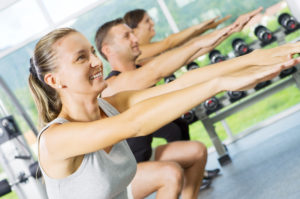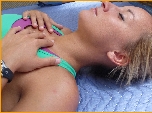Abdominals/Core
Sample Class: More for the Core
Strength is important, but functional strength is essential—and for this, variety is key. “More for the Core” takes participants through a flowing mix of methods, disciplines and combinations that engage and activate even the tiniest muscles with continuous, dynamic movement. It’s a perfect way to prepare the body for activities of daily living. More for the Core Details
format: core-specific Total Time: 60 minutes Equipment: none
Peaceful Meditation Meets Intense Core Training
If you’ve never been to the Inner IDEA® Conference, it will be hard for you to envisage how holistic the programming is. Imagine beginning your day outside with a series of sun salutations by the waterfall or inside with a seamless blend of tai chi, qigong and yoga, taught by a master. After breakfast you spend 2 hours becoming intimately aware of your psoas, or you discover how a transfusion of sound and light and visual beauty and even taste can turn your Pilates reformer classes into a feast for the senses.
The Core as a Cylinder
Core work has gained a lot of attention in the past several years, focusing on everything from injury prevention to athletic power. How we choose to define the core influences how we integrate it into our self-image and into our movement. If incomplete or compensatory patterns are repeated often enough, and long enough, they become habitual. Only when a change takes place on the level of the nervous system are we able to move past these habits and permanently improve strength, posture and flexibility (Shumway-Cook & Woollacott 1986).
Which Exercise Is Best for Abdominal Activation?
The development of a strong and stable core has been linked to better physical performance, less back pain and other benefits. There are many exercises designed to strengthen the core, but which are most effective? This question was posed in a recent issue of the Journal of Orthopaedic & Sports Physical Therapy (2010; 40 [5], 265–76).
Preparing for Instability
In recent years the popularity of functional exercise and core training has grown dramatically. The belief that you’ll engage your core when standing, running, balancing and/or exercising on an unstable surface—and that this is more functional than working on a stable surface—has encouraged the use of equipment that challenges stability, particularly in the standing position. Even though it is possible to stabilize without properly engaging the core, a growing number of people are now training on unstable surfaces.
Plank for a Purpose
IDEA presenter and author Stacey Lei Krauss has challenged everyone in the world to show her their best plank. “Our message is simple: the plank is an exercise for body, mind and spirit,” says Krauss. She believes that the more people engage mind, body and spirit, the stronger they will become.
Core Stability for Enhanced Daily Function
It’s early morning, and you arrive at the gym to discover a voice message from your 8:00 am client, Mary. She has called to let you know she will be unable to make her appointment because she has strained her back and is laid up in bed—for the third time this month. A consummate professional, you call to follow up with her. Mary explains that she “did something” to her back as she was rushing to get the kids off to the school bus. You wish her well, hang up the phone and contemplate her injury.
Morning Core Routine
%{Video}%
@VIDEO_NODE:25353@
Core Training Duo
How do you transition students quickly from the main part of class to the core-conditioning exercises? With larger classes and limited space and equipment, you may want to add creative partner-based moves.
Both single and partner-based core-training exercises should target specific muscle groups. The core consists of many different muscles that stabilize the spine, pelvis and shoulder and provides a solid foundation for total-body movement. A strong core distributes weight-bearing loads and helps protect the low back.
Sample Class: Abdominal/Core Circuit
This versatile circuit class can be applied to groups of almost any size and fitness level and is limited only by your ability to organize, instruct and train.
Abdominal/Core Circuit Details
Format: a circuit that focuses on the abdominals and core
Total Time: approximately 30–40 minutes/…
A Ball for All
The stability ball has been used by physical therapists for years, and the fitness industry has fully embraced this tool for group exercise and private training. The stability ball creates an unstable surface and can be used for strength, balance, coordination, agility, core work and flexibility. Some of my favorite exercises challenge both balance and core strength. For review purposes,…
Latest Trends on Health and Fitness
IDEA Health & Fitness Association, the leading membership organization of health, wellness and fitness professionals worldwide with more than 21,000 members in over 80 countries, has announced the findings of its annual IDEA Fitness Programs & Equipment Survey. In its 12th year, the survey revealed an increasing range of activities and gear that are specially targeted to meet the diverse n…
Core Conditioning and Athletic Performance: Is There a Connection?
Core conditioning has quickly become a major component of many athletic training programs; however, recent research questions the validity of claims that it enhances athletic ability. The Indiana State University study tested the core strength of 29 NCAA Division I football players and compared the results to the athletes’ abilities in three strength variables and four performance
varia…
Three-Way Plank
img src=”/files/article_images/20…
More expert advice on pumping iron
Diving headfirst into your fitness resolutions for the year, you might have told your friends you really just want to improve your overall health.But let's be honest. Women want a tight rear and lean, muscular legs.Men want a barrel chest and arms like a rolled roast.Both men and women want six-pack abs.We've put together a few ways to attack those areas – chest, ar…
Central Moves
The core holds the body in alignment and allows the extremities to move in a more efficient and effective manner. Pilates helps increase core strength and stabilization by creating simultaneous demands for strength and flexibility. The result:
enhanced movement quality. The body moves the way it was designed to move. The following exercises move progressively from one movement pattern t…
Eight-Step Abdominal Strength Assessment
The most common error made in roll-up or trunk-curl general instruction is not matching the client’s strength level with the appropriate level of demand. This should be a reminder that disciplines such as yoga and Pilates require personalized instruction and attention to detail. ..
Prenatal Progess
Strong core muscles are vital for helping prenatal participants offset pregnancy-related postural changes that can cause back pain and other discomforts. The following basic exercises are appropriate for virtually all prenatal and postpartum women. The moves are also excellent for…
Activate and Stabilize
Use modified Pilates exercises in your class. Many group fitness instructors use traditional Pilates exercises in the core-conditioning sections of their classes.
Pilates Improves Fitness and Trains Core Muscles
Regular Pilates mat classes can significantly improve body composition, flexibility and core musculature endurance, according to results from two small Pilates studies presented at the 2006 annual meeting
of the American College of Sports Medicine, held in Denver, Colorado.
In one study, from Barry University in Miami Shores, Florida, researchers followed 22 participants with n…




